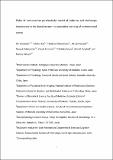Roles of centromedian parafascicular nuclei of thalamus and cholinergic interneurons in the dorsal striatum in associative learning of environmental events
Author(s)
Yamanaka, Ko; Hori, Yukiko; Minamimoto, Takafumi; Yamada, Hiroshi; Matsumoto, Naoyuki; Enomoto, Kazuki; Aosaki, Toshihiko; Graybiel, Ann M; Kimura, Minoru; Graybiel, Ann M.; ... Show more Show less
Download702_2017_1713_ReferencePDF.pdf (595.3Kb)
OPEN_ACCESS_POLICY
Open Access Policy
Creative Commons Attribution-Noncommercial-Share Alike
Terms of use
Metadata
Show full item recordAbstract
The thalamus provides a massive input to the striatum, but despite accumulating evidence, the functions of this system remain unclear. It is known, however, that the centromedian (CM) and parafascicular (Pf) nuclei of the thalamus can strongly influence particular striatal neuron subtypes, notably including the cholinergic interneurons of the striatum (CINs), key regulators of striatal function. Here, we highlight the thalamostriatal system through the CM–Pf to striatal CINs. We consider how, by virtue of the direct synaptic connections of the CM and PF, their neural activity contributes to the activity of CINs and striatal projection neurons (SPNs). CM–Pf neurons are strongly activated at sudden changes in behavioral context, such as switches in action–outcome contingency or sequence of behavioral requirements, suggesting that their activity may represent change of context operationalized as associability. Striatal CINs, on the other hand, acquire and loose responses to external events associated with particular contexts. In light of this physiological evidence, we propose a hypothesis of the CM–Pf–CINs system, suggesting that it augments associative learning by generating an associability signal and promotes reinforcement learning guided by reward prediction error signals from dopamine-containing neurons. We discuss neuronal circuit and synaptic organizations based on in vivo/in vitro studies that we suppose to underlie our hypothesis. Possible implications of CM–Pf–CINs dysfunction (or degeneration) in brain diseases are also discussed by focusing on Parkinson’s disease.
Date issued
2017-03Department
Massachusetts Institute of Technology. Department of Brain and Cognitive Sciences; McGovern Institute for Brain Research at MITJournal
Journal of Neural Transmission
Publisher
Springer Vienna
Citation
Yamanaka, Ko, et al. “Roles of Centromedian Parafascicular Nuclei of Thalamus and Cholinergic Interneurons in the Dorsal Striatum in Associative Learning of Environmental Events.” Journal of Neural Transmission, vol. 125, no. 3, Mar. 2018, pp. 501–13.
Version: Author's final manuscript
ISSN
0300-9564
1435-1463